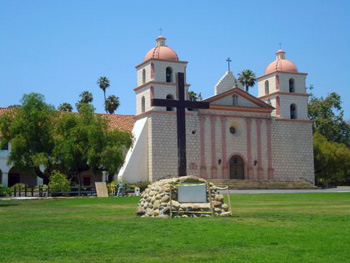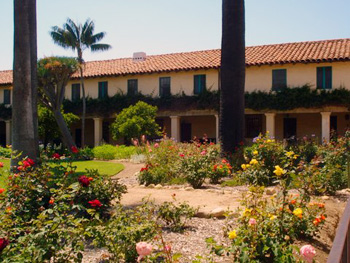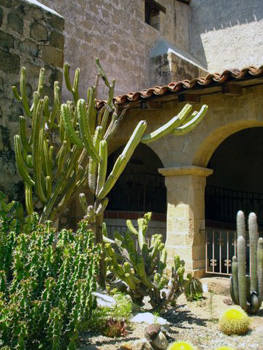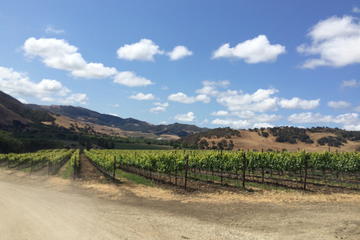
California
by W. Ruth Kozak
Santa Barbara California is a city of white-washed Spanish style buildings with red tile roofs tucked between the mountains and sea. The palm-lined streets and long stretch of white sandy beach give it an exotic allure. There were no trees here when the Spanish came; no palms lining the beaches and boulevards, no wooded hillsides. It was simply a barren swath of coastline occupied by the Chumash people who were hunters and gatherers oriented to the sea.
 On this sunny afternoon I have a special destination in mind: a visit to the Old Mission Santa Barbara to discover the city’s past. I hop onto a tourist trolley down by the Presidio. On the way through the picturesque streets, the handsome driver tells us that he’s a descendant of the Chumash Indians who occupied this land long before the arrival of the Spaniards. In 1602 a Spanish explorer named Sebastian Vizcaino sailed up the channel between the coast and Channel Islands, and claimed the land in the name of the king of Spain. He gave it the name “Santa Barbara” because it was the Saint’s Feast day.
On this sunny afternoon I have a special destination in mind: a visit to the Old Mission Santa Barbara to discover the city’s past. I hop onto a tourist trolley down by the Presidio. On the way through the picturesque streets, the handsome driver tells us that he’s a descendant of the Chumash Indians who occupied this land long before the arrival of the Spaniards. In 1602 a Spanish explorer named Sebastian Vizcaino sailed up the channel between the coast and Channel Islands, and claimed the land in the name of the king of Spain. He gave it the name “Santa Barbara” because it was the Saint’s Feast day.
The tour bus passes by various historical buildings in the old town and heads up the winding road. On the outskirts, a majestic building crowns the hillside, glowing like an opal in the bright California sun. This is the Queen Mission, the tenth founded by Franscisan Padre Junipero Serra, established December 4, 1786.
Disembarking from the trolley I stand in awe as I observe the impressive building with its twin bell towers and the imposing architecture that combines Moorish, Mexican, Chumash Indian and Spanish design.
In the mosaic-paved entryway a Moorish fountain dating back two hundred years burbles with a spray of water. The large basin in front is the lavandaria where Chumash women washed their clothes. The crude lions head at the front of the lavandaria was carved by a Chumash artisan. Nearby is a botanical garden dedicated to native plants used by the Chumash people.
I set off on a self-guided tour. Inside, the small, dark rooms contain a colonial art collection of the baroque or neoclassical eras, imported from Mexico and South America that demonstrate the life of the Franciscan monks and the pioneers who lived there alongside the Chumash Indians. Three stone statues depict St. Barbara and the Virtues, carved by a mission Indian who used pictures in books as a guide.
 Over time the original buildings were damaged or destroyed by earthquakes. The present friary was restored then later built after another quake in 1927. The church represents an amazing engineering achievement combining the efforts of the Chumash, Spanish and Mexican artisans. I tour the rooms where the missionaries slept, the kitchen where a meager menu is shown: little more than beans and rice. In the chapel room are displays of skills taught there including candlemaking, pottery, weaving and ironwork. Galleons from Manila and China clippers brought Asian culture to the area and some of this reflects in the artifacts and embroidered silk vestments displayed in the chapel museum. The church itself is decorated with Mexican art, some 200 years old.
Over time the original buildings were damaged or destroyed by earthquakes. The present friary was restored then later built after another quake in 1927. The church represents an amazing engineering achievement combining the efforts of the Chumash, Spanish and Mexican artisans. I tour the rooms where the missionaries slept, the kitchen where a meager menu is shown: little more than beans and rice. In the chapel room are displays of skills taught there including candlemaking, pottery, weaving and ironwork. Galleons from Manila and China clippers brought Asian culture to the area and some of this reflects in the artifacts and embroidered silk vestments displayed in the chapel museum. The church itself is decorated with Mexican art, some 200 years old.
 Passing under a low doorway decorated with skulls I enter the mission cemetery where Santa Barbara‘s culturally diverse early settlers are buried along with Chumash Indians. When the Presidio was formed in 1783 the Spanish soldiers were of varied ethnic origins including Mexican Indians, Sephardic Jews and Africans. The heritage of Santa Barbara is reflected in the names and backgrounds of those buried there.
Passing under a low doorway decorated with skulls I enter the mission cemetery where Santa Barbara‘s culturally diverse early settlers are buried along with Chumash Indians. When the Presidio was formed in 1783 the Spanish soldiers were of varied ethnic origins including Mexican Indians, Sephardic Jews and Africans. The heritage of Santa Barbara is reflected in the names and backgrounds of those buried there.
In the tranquil Mission garden I pause and imagine what life for the Chumash people was like back then. This garden was once a work area where many of them learned trades. Their workshops and living quarters were located in the surrounding quadrangle of buildings. Today many descendants of the Chumash, such as the driver of the tour trolley, still live in Santa Barbara. Fortunately their customs didn’t die out and today local native communities provide support for the preservation of their ancient culture.
The Mission’s original purpose was the Christianization of the Chumash but once Spain lost California to Mexico in 1822, it was secularized although missionaries were allowed to conduct services. Eventually it was returned to the Catholic Church and used as a school and seminary. Today it is used by the Parish of Santa Barbara and stands as a monument to the cultural diversity of California’s heritage.

Santa Barbara Wine Lovers Tour
If You Go:
♦ www.sbmission.org
Mass celebrated daily 9 – 5; Sunday 7.30,9 and 10 a.m. and noon.
Admission $4. adults.
2201 Laguna St. Santa Barbara CA
Phone: 805-682-4713
♦ Santa Barbara Trolley Tours
www.sbtrolley.com
805-965-0353
About the author:
Ruth is a travel and historical fiction writer and one of her favorite North American destinations is California. On a visit to attend her grandson’s graduation from the Santa Barbara University, she made this fascinating visit to the old mission of Santa Barbara.
All photos are by W. Ruth Kozak.


